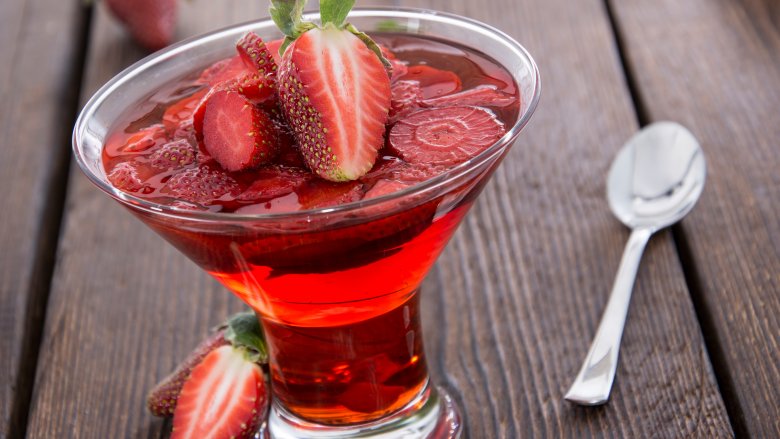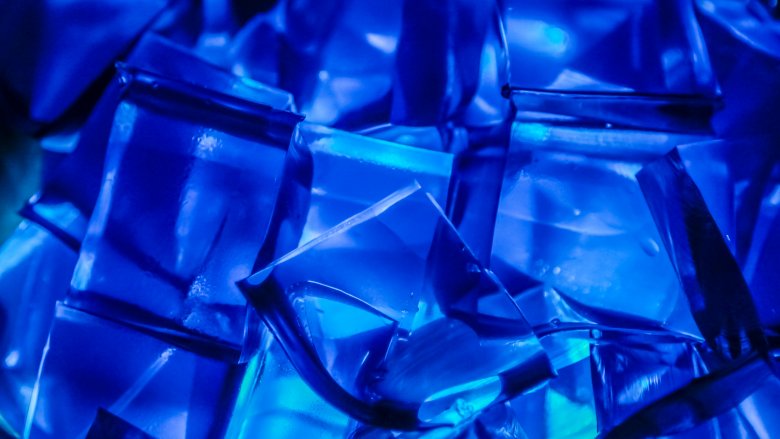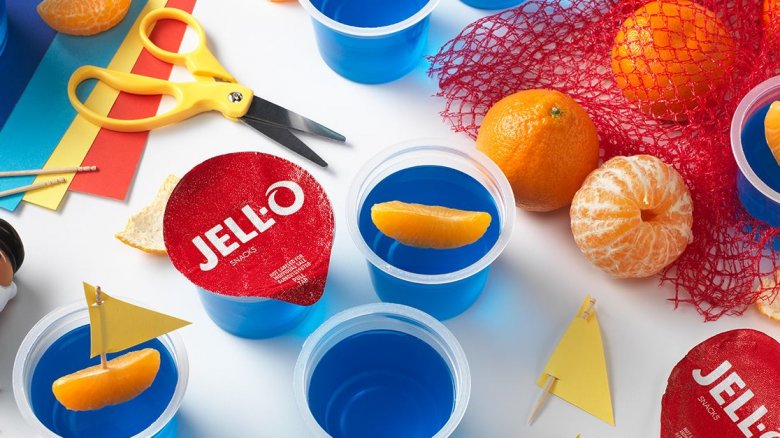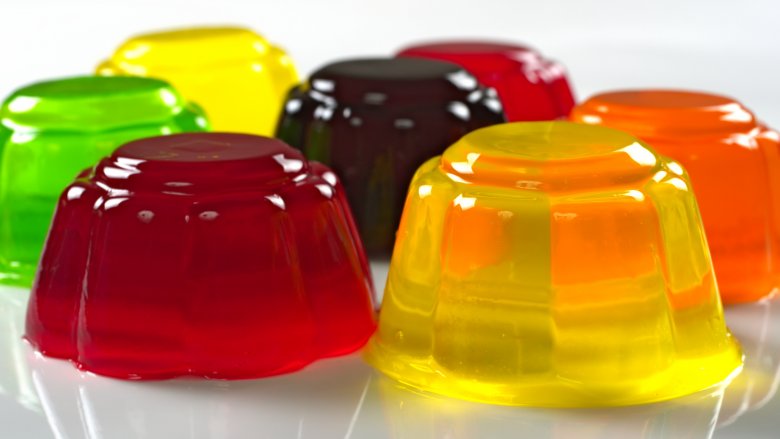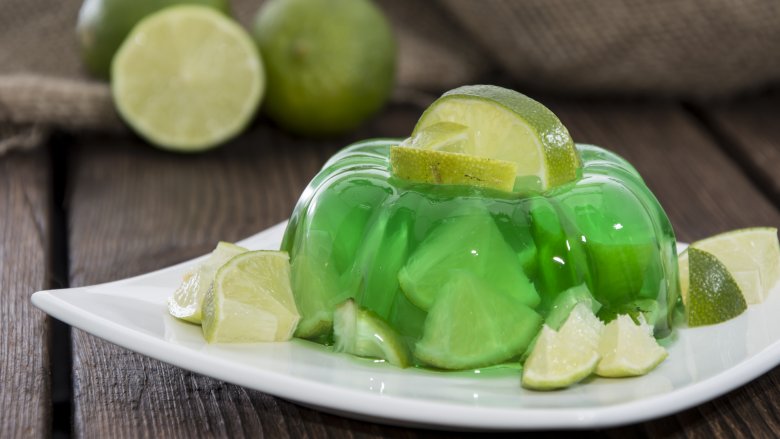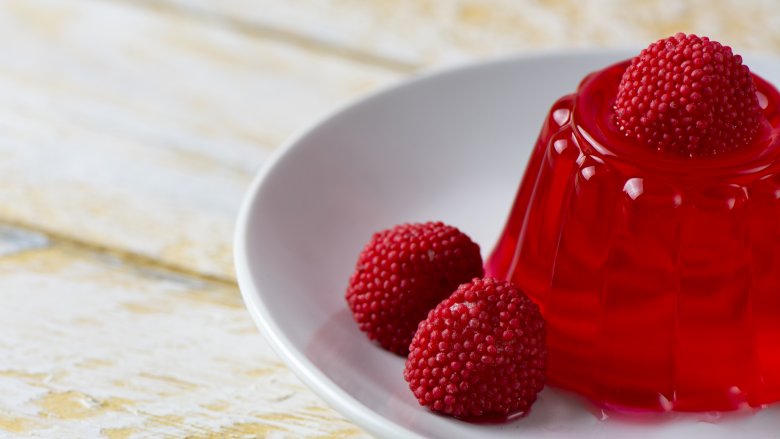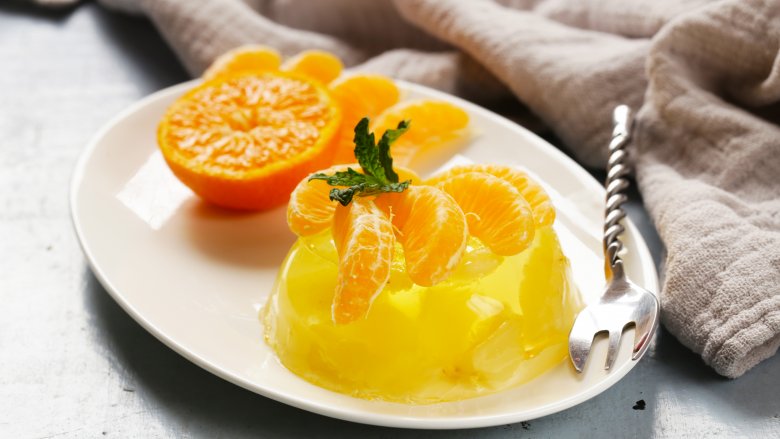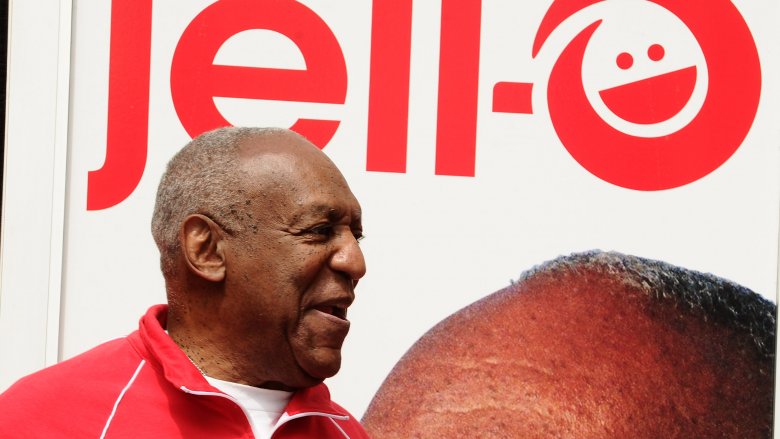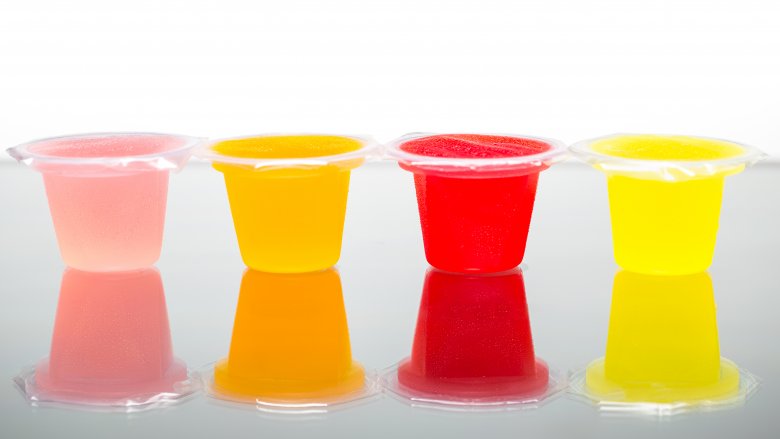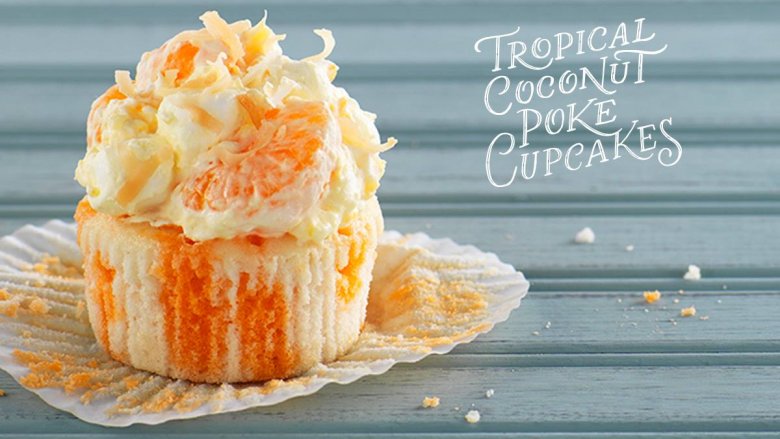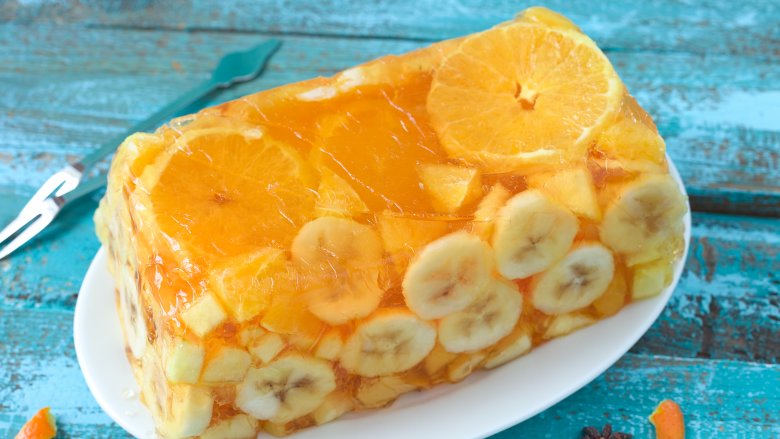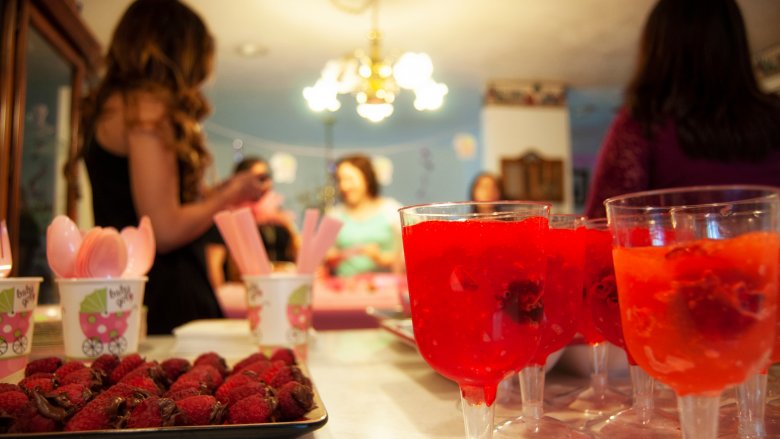The Untold Truth Of Jell-O
Jell-O is weird stuff, and we're not even just talking about that love-or-hate texture and that odd, colorful transparency that makes it perfect for Halloween desserts. It's actually a modern name brand that has a long history stretching all the way back to medieval kings. So actually, if you're looking for something semi-authentic for your next Game of Thrones party, feel free to take your favorite Jell-O-based dessert.
Today, Jell-O is popular because it's fun, easy, and inexpensive, but it's also been a sweet treat only the elite could once afford. It's been a status symbol, a staple on hospital and prison trays alike, and it's also been the subject of some unsettling science experiments. There are more uses for it than you expect — so many, you should probably always keep a box or few in your kitchen — and you might be surprised to find it's not made from the stuff you think it's made from. It's a childhood favorite, sure, but it's so much more than that!
Inventing Jell-O was the easy part
Jell-O isn't all gelatin, but gelatin is the main ingredient. In the 19th century, gelatin was as popular as it was time-consuming to make, until one American inventor decided this centuries-old ingredient needed an upgrade. In 1845, Peter Cooper patented a method of making "Portable Gelatin" in sheets that were then ground into powder and only needed to be put in water to make the same substance that had once taken hours. (You might not know the name Peter Cooper, but you know about his other major invention: the steam engine.)
Cooper never commercialized his invention, but Pearl and May Wait of Leroy, New York, did. Sort of. Gizmodo says they started out running a cough syrup and laxative business, and they stumbled on a way to combine that business with their love of desserts. They started with bland, tasteless, gelatin, then added flavored fruit syrups.
It was a brilliant discovery, but they couldn't afford to market it themselves. In 1899, the Waits sold everything — including the formula and patent — to one of their neighbors for what's roughly $12,000 in today's money. It was the neighbor, Orator Frank Woodward, who made Jell-O into a sensation.
It marked a turning point in food
History says the non-name-brand versions of Jell-O — gelatin and aspic — have been around for centuries. The ancient Romans had a version made from fish (but they used it for glue), and starting in the Middle Ages, gelatin was made by boiling pigs' ears and feet.
Before Cooper's invention, making gelatin and aspic was so time- and labor-intensive, it was reserved for the people who had a little extra cash laying around... and servants and chefs who needed something to do. Jell-O's clear, solid precursor was the perfect way to display a dish, and according to Vice, medieval chefs had a particular fondness for showing off their skills by using it to display fish as if they were still swimming.
But Jell-O cut out the time-consuming part, and the different flavors allowed Jell-O to stand alone as a dessert. It wasn't an overnight success — Gizmodo says Woodward was once so done with Jell-O that he offered to sell the whole lot for $35 — but thanks to a single ad in Ladies Home Journal, Jell-O became "America's Favorite Dessert," just like the ad said.
Where that -O came from
The J-E-L-L-O jingle dates back to 1934, when it was sung on the newly blossoming media of radio. Jack Benny was the first one to sing it, and that brings up an important question: why the -O?
Strangely, it's not the creative, one-off bit of product naming you might expect. According to The Dictionary of Trade Names Origins (via Gizmodo), adding -O onto a more generic sort of term to make a product name was massively popular at the turn of the 20th century. Jell-O wasn't the only one to do it, (there's also a Grain-O, for example), but it's the one we think of today.
The whole name was the work of May Wait, and she apparently used both the words "jelly" and "gelatin" as inspiration for the "Jell" part of the name. She tacked the "O" on because it was trendy, and also an easy way to trademark a well-known word.
It's alive... kind of
So, here's a weird thing. We know a lot about the human body, but some of the basics continue to baffle. One of the things we're not 100 percent sure of is when a person really, truly, is gone. It seems straightforward, but once you get into the territory of life support and prolonging physical life, we have to ask ourselves at what point the person just isn't there anymore. Is it when you can prove they're brain-dead?
What does this have to do with Jell-O? It turns out, if you hook Jell-O up to an EEG machine, there's enough jiggling going on in there that if you just look at the machine's readout, it would say it's legally alive.
Dr. Adrian Upton proved it way back in 1974, and The Straight Dope says that while it didn't come as a complete surprise, it did bring up an important point about how little we knew — and how little we still know — about brain functions. The waves that register from Jell-O hooked up to an EEG are small, not unlike a very ill person, but it's also eerie proof of why doctors need to administer several tests to figure out if how far gone someone really is. Thanks, Jell-O.
Jell-O, Mormons, and Utah
Everyone loves Jell-O, but not as much as Utah does. Jell-O is the official state snack of Utah, and when Salt Lake City hosted the 2002 Winter Olympics, Jell-O was immortalized in one of their collectible pins (via Slate).
In the late 1990s, sales for Jell-O were slipping overall, and marketing execs knew they needed to come up with a way to revitalize sales—and to move away from unsavory uses like Jell-O shots and Jell-O wrestling. They decided to rebrand Jell-O as being the perfect dessert for kids (it's fun) and for families (it's easy and affordable). When they looked at states to target marketing of their new Jell-O Jigglers, Utah's high birth rates and big families made it the perfect state.
It wasn't long before Mormon families became associated with Jell-O — which makes sense since they do make up a large portion of Utah's population. Thrillist notes there are a few reasons Jell-O is the perfect fit for the Mormon lifestyle: it's great for bringing to large-scale functions, and it's the perfect dessert to serve a lot of kids. It's a win for everyone.
It's been used to create some iconic movie scenes
Everyone knows that Jell-O is versatile, but did you know it's even been used to help create some of the most iconic movie scenes ever?
The 1956 classic The Ten Commandments still gets regular holiday air time, but the original version, filmed in in 1923, used Jell-O to film one of the most famous scenes. The AV Club says in the original version, those quivering, ominously trembling walls of water the Israelites pass through were made completely of Jell-O!
Steven Spielberg also enlisted the help of red Jell-O-filled glass dishes to get the spacecraft lighting right in Close Encounters of the Third Kind (via Empire), and it was also used in John Carpenter's The Thing. One of the most iconic scenes — the one Mental Floss says is affectionately known as the "chest chomp" — was done with help from a double amputee and two prosthetic arms made from wax, rubber, and Jell-O.
It heralded a shift in hospital care
Anyone who's ever been in the hospital or visited someone there knows that Jell-O is a staple when it comes to the limited culinary offerings on most medical center menus. According to Tufts Medical Center, there's a specific reason for that. Many patients recovering from a wide range of surgeries or procedures are restricted to a "clear liquid" diet. Those clear liquids are easy to digest, and Jell-O is considered a liquid because it turns into one as it gets warmer.
Strangely, Eater notes there's something else going on here. Once, patients were often given over to the care of nurses who would spend part of their days serving things like scratch-made beef and chicken broth, homemade custards, and wine jelly. They pinpointed the exact year a change came: 1904, with the publication of a book more focused on nutrients and calories instead of deliciousness.
And that was about the same time Jell-O hit the market, along with foods like ginger ale, powdered soups, and powdered custard. That also coincided with another shift: male doctors were taking over from home-care nurses, medical treatments became more institutionalized, and ready-made meals became the go-to.
Is it really made from hooves?
Haters often condemn Jell-O as being made from horses' hooves, and we're happy to say that's not true. It is, however, a little complicated.
It's absolutely true that early gelatins and aspics used to be made by boiling the feet of hoofed animals. History says that was most commonly pigs' feet (along with their ears), but here's the thing — the boiling releases collagen, which is basically an animal protein that's present in hides, bones, and in other parts, like those pigs' ears.
But there's no collagen in the hooves themselves. That particular part of the animal, says LiveScience, actually contains another protein called keratin. (ScienceDirect confirms it's the same protein found in our own skin, nails, and hair.) Boiling the bones is actually getting the collagen out of other structures, and gelatin is essentially collagen that's been broken apart by heating then cooled until it reforms into a new structure built around water. That's why it's jiggly... and that doesn't really make it less weird, does it?
Bill Cosby and Jell-O
There are few advertising spokesmen so firmly associated with their product as Bill Cosby is with Jell-O, and that's given Jell-O some major headaches. First, a little history.
Cosby was connected with Jell-O for a long, long time. CBS News says he was a spokesman for the brand from 1974 to 1999, and Jell-O even reconnected with him in 2010 for another set of ads. Sales were falling, and Cosby's work with the company had been so popular they saw renewing the partnership as a way to help recover from those flagging sales. (If you don't remember those later ads, that's not surprising — he was mostly behind the camera.)
But everyone knows about the dark turn Cosby's life and career took, and according to MarketWatch, the advertising world really doesn't want anything to do with him now, either. Cosby had been inducted into the hall of fame of the American Advertising Federation, and following his conviction as a sex offender in 2018, he became the first person ever expelled.
There's an odd follow-up to Cosby's career as Jell-O spokesman, says CNN. For one of his first meals as Inmate No, NN7687, he was served half a cup of Jell-O.
Prison food staple
It's a favorite of kids, a staple in hospitals... and a staple in prisons. You can't get much more varied than that, and in 2003 CBS News reported that state officials were suddenly asking why prison inmates were being given dessert. Namely, why were they being allowed to enjoy the delicious, jiggly fun that is Jell-O.
The question came up amid a search for a way to cut costs in the nation's prisons, and it was Minnesota's Rep. Marty Seifert who proposed cutting Jell-O from prison menus. But here's the thing — prisons are required to serve their inmates a certain number of calories a day, and Jell-O is a super-cheap way to get those calories in. Minnesota officials estimated if they were to get rid of Jell-O desserts and replace it with something else, they'd increase their food budget by around half a million dollars a year. Prisons got to keep their Jell-O.
There's a ton of weird stuff you can do with it
Jell-O isn't just for making your own jiggly desserts.
Next time you find yourself reaching for some boxed cake mix, dress it up a little with Jell-O. Bake the cake as usual, then let it cool slightly. Grab a box of Jell-O, dissolve in boiling water, then add some cold water. Poke holes in the top of your cake, pour in the Jell-O, then pop it in the fridge. When you cut it, you'll have a pretty awesome-looking throwback cake; Jell-O poke cakes were once hugely popular.
You can also use it to make marshmallows (just replace plain gelatin with your favorite flavor of Jell-O), or add it to your favorite homemade ice cream to help keep it soft in the freezer. A dash of Jell-O mixed in with your whipped cream will also help it stay firm. One tablespoon of Jell-O mix and three tablespoons of water will act as an egg replacement, and you can also use it to make some all-natural gummies. A fan of turmeric or cinnamon? Mix some with a dash of honey, water, and Jell-O then cut into bite-sized pieces for tasty supplements.
How Jell-O salads became popular
Let's talk about the elephant in the room: the weirdness that is Jell-O salads. Americans went through a phase where they were encasing almost anything in Jell-O, and while fruit-based dishes might be completely acceptable, molded Jell-O filled with meats is not.
These Jell-O salads had a lot in common with menu items from the Middle Ages, but why weren't these left in the past, too? For a few reasons. Post-war, Serious Eats says there needed to be another reason to use Jell-O, but the convenience factor was a problem. Housewives didn't want to be seen as lazy, so they made Jell-O more complicated by adding a ton of other ingredients. As a bonus, those other ingredients could often be leftovers and that capitalized on the need to use everything while not seeming thrifty.
The Daily Meal says there was a bit of something else at play. Just like gelatin dishes were a status symbol in the Middle Ages, modern Jell-O salads came with a bit of status, too. Show up to any 1950s dinner with one of these, and it meant you could afford a refrigerator big enough you had space to spare.
It's been blamed for making cooking "women's work"
Vintage advertising is pretty eye-opening when it comes to seeing how roles were once defined for men and women, and according to Allie Rowbottom, the great-great-great-niece of Jell-O pioneer Orator Woodward (via Vanity Fair), Jell-O and their advertising played a large part in encouraging the idea that women belonged in the kitchen.
While it's not the only reason women spent decades at home and in the kitchen, it is true Jell-O's rise to culinary fame came with a marketing campaign targeted at a specific sort of woman: the housewife. The Jell-O Girl marketed the product by tugging on heartstrings through the 1930s, during World War II women were encouraged to do their part and feed their families with the help of Jell-O. By 1959, Jell-O was marketing itself as a "Bride's Best Friend." Getting married meant taking care of your man, after all, and Jell-O was there to help. Notice a trend?
The more popular Jell-O got, the more influential it was over cooking and trends. Jell-O was marketed to women, it told them where their place was, and even later, it was marketed toward women defined by their families.
